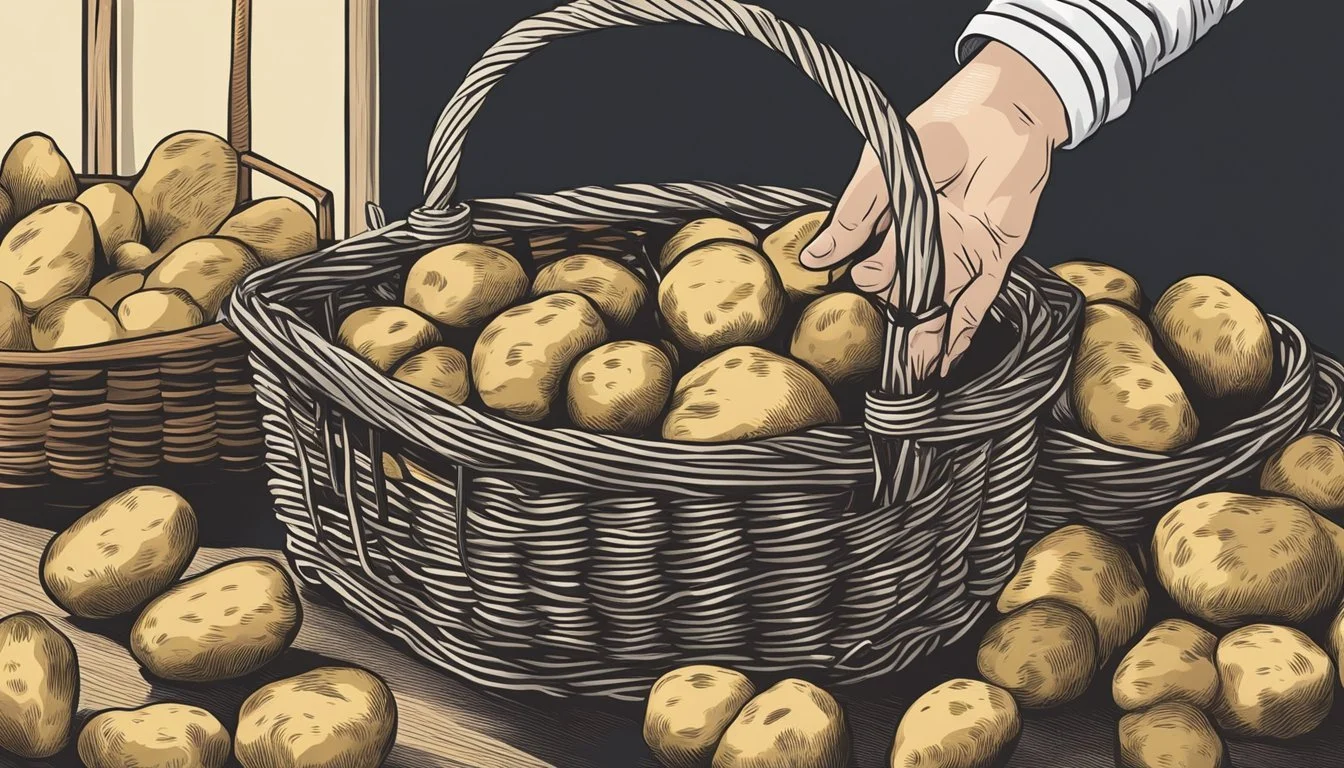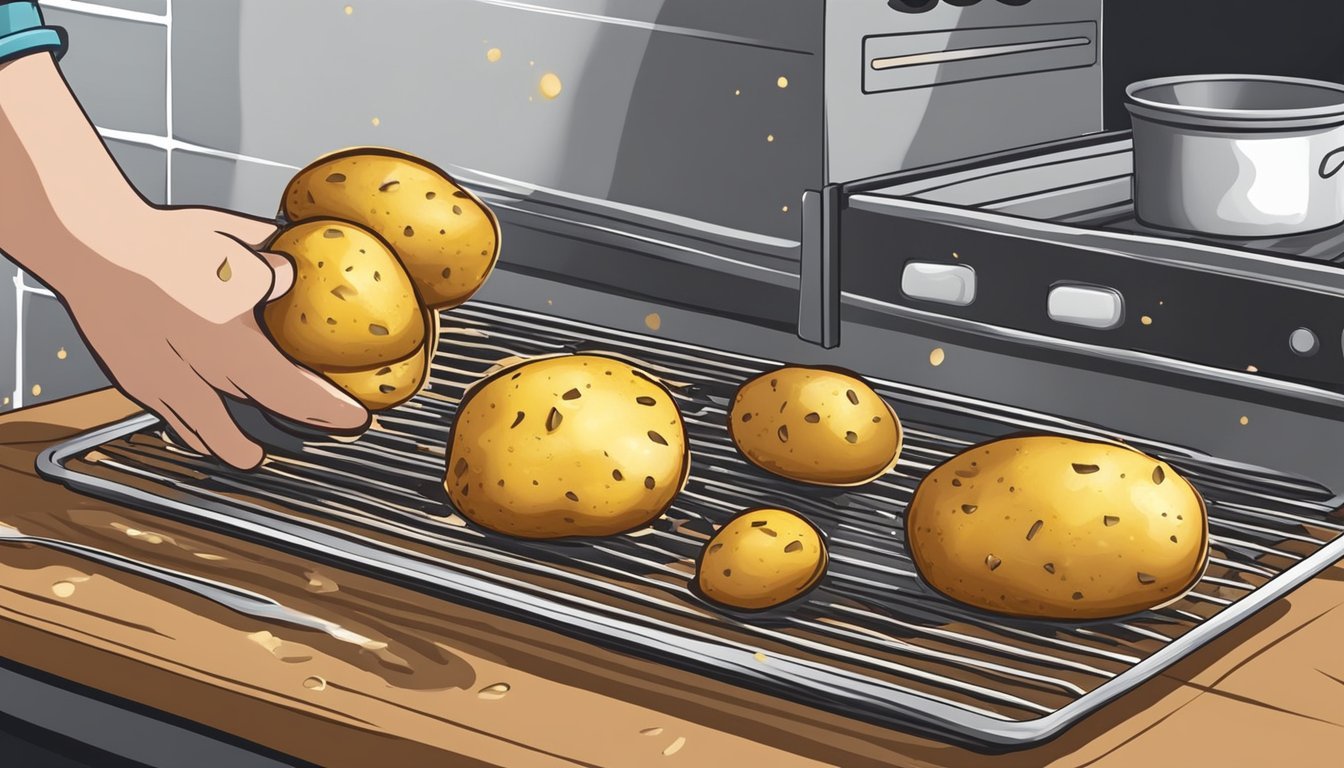Potatoes for Baking
Choosing the Best Varieties for Perfect Results
When it comes to baking the humble potato, the type you choose is crucial for achieving the perfect texture and flavor. Idaho and Russet potatoes (What wine goes well with potatoes?) are highly regarded for these types of potato recipes because of their high starch content and low moisture levels, which contribute to a fluffy and airy interior that's the hallmark of a well-baked potato. These varieties also have thick outer layers that turn into crispy potato skins in the oven, providing a satisfying contrast to the soft flesh inside. In contrast, waxy potatoes like Yukon Golds may not yield the same light texture, although they too can be used for baking when a firmer bite is desired.
The correct preparation of potatoes before baking can significantly influence the outcome. Puncturing the skin of the potato with a fork, for example, allows steam to escape during cooking, preventing the potatoes from bursting and ensuring even cooking throughout. The oven plays an equally important role, with consistent, high temperatures being key to crisping the skin and evenly cooking the potato within. Each variety, whether high in starch like the russets and sweet potatoes, or slightly waxy like Yukon Golds, will respond differently to the baking process, making the choice of potato and baking method integral to the dish's success.
Selecting Potatoes
The success of a baked potato dish hinges on choosing the right type of potato. Not all potatoes deliver the same results when baked, as the starch content and texture are key determinants of the finished product's quality.
Types of Potatoes
When picking potatoes for baking, one will encounter a variety of options, among which the Russet Potato is the acknowledged leader. Known for its classic baked potato qualities, the Russet features a fluffy, starchy interior that crisps well on the outside. Idaho Potatoes are a subset of russets known for their hearty size and excellent baking quality.
Other varieties include yellow potatoes, like the popular Yukon Gold, which offer a slightly waxier texture but still hold up well in the oven. Sweet potatoes are a nutritious alternative, boasting a sweeter flavor and denser texture. Conversely, red-skinned potatoes, known for their firm texture, are not commonly preferred for baking on their own, but can be included in a medley of roasted vegetables.
Starch Content and Texture
Potatoes are typically classified by their starch content, which has a significant impact on their texture once cooked.
For those looking forward to baking potatoes the right way, what you're looking for is a fluffy interior and a crisp skin, high-starch potatoes like Russets or Idahos are the go-to choice due to their low moisture content. On the other hand, medium-starch potatoes, such as Yellow potatoes, offer a balance between starchiness and moisture, resulting in a creamy texture that still maintains its shape after cooking. For dishes that require a firmer texture, low-starch potatoes are preferred; these include Red-skinned potatoes and some varieties of sweet potatoes, known for their waxy and firm consistency.
Each type of potato, from the fluffy and crispy Russet to the soft and dense sweet potato, brings a unique texture to the table, making it essential to select the right type of potato based on the desired outcome of the dish.
Preparation and Baking Techniques
Selecting the right potatoes and executing proper preparation and baking techniques are crucial for creating the perfect baked potato. The process involves meticulous cleaning, precise puncturing for steam release, and maintaining optimal baking conditions.
Cleaning and Scrubbing
Before baking, one should thoroughly wash potatoes using a vegetable brush under cool running water to remove dirt and potential residues. It's important to eliminate any sprouts or green spots using a potato peeler or a small knife, as these can be toxic.
I highly recommend purchasing a vegetable brush online for a convenient shopping experience!
Poking Holes and Seasoning
After cleaning, potatoes must be pricked on all sides with a fork to allow steam to escape during the baking process. Once dry, the potatoes can be rubbed with olive oil, vegetable oil (how long does vegetable oil last?), or butter, and seasoned generously with kosher salt and ground black pepper, which will enhance flavor and contribute to a crispier skin.
If you're looking for olive oil or vegetable oil, kosher salt, and ground black pepper, buying it online is your best bet!
Baking Temperature and Time
The oven should be preheated to a high temperature, typically around 400°F to 425°F. The potatoes are then placed on a prepared baking sheet, which can be lined with foil for easier cleanup. The cooking time generally ranges from 45 minutes to 1 hour, depending on the size of the potatoes. They are done when a fork or knife can easily pierce through the flesh without resistance.
When it comes to getting the best deals, buying baking sheet online is the way to go!
Serving and Toppings
Baked potatoes provide a versatile canvas for an array of toppings, allowing for both classic flavor combinations and innovative twists. Whether one is seeking comfort food or a gourmet side dish with crispy skin, the right toppings can transform a simple baked potato into a delightful meal.
Classic Baked Potato Toppings
Traditional toppings for baked potatoes are beloved for their simplicity and the perfect balance of flavors they offer. A pat of butter melting into the fluffy interior of a hot potato is a quintessential starting point. Adding sour cream contributes a cool tanginess, while a sprinkle of salt and pepper seasons the dish to perfection. For a richer experience, shredded cheese slowly melting over the top alongside crispy bacon (how long does bacon last?) bits provides a satisfying texture and taste. Finishing the potato with a sprinkle of chopped chives (how long do chives last?) adds both color and a mild onion-like flavor.
The essential butter enriches the potato, while the addition of sour cream introduces a layer of creaminess. Seasoning with kosher salt and pepper is key for bringing out the flavors. The gooey texture and taste from the shredded cheese enhance the dish's richness, and the bacon bits offer an element of crunch and savoriness. Lastly, the chives deliver a hint of freshness and a pop of color to the final presentation.
Innovative Topping Ideas
For those looking to elevate their baked potato, your next favorite toppings may add a unique twist. Drizzling olive oil can impart a distinct, fruity flavor that differentiates it from the traditional buttery taste. Experimenting with different types of cheeses, such as blue cheese or gouda, can add new dimensions of flavor to your twice-baked potatoes. Dressing the potato with foodie favorites like pesto, sundried tomatoes, or roasted red peppers can transform it into a gourmet experience. Even international variations can be explored, like topping with tzatziki sauce and feta for a Greek-inspired version.
Incorporating olive oil as a flavorful alternative to butter can add a new taste profile to your baked potato. Introducing a variety of cheeses opens up a world of new flavor profiles, making each bite interesting and unique. Adding pesto or sundried tomatoes introduces a Mediterranean flair to the dish, while a combination of tzatziki and feta cheese adds a delightful Greek twist that's sure to please the palate.
Making a Meal with Baked Potatoes
Loaded baked potatoes are substantial enough to serve as a main course. One can start by ensuring the potato is well-coated with butter or olive oil to create a crisp exterior. The addition of hearty toppings such as chili adds protein and spice, making the dish more satisfying. Combining sour cream, shredded cheese, bacon, and a dollop of chili can turn a basic potato into a sumptuous and complete meal. The key is to balance the flavors and textures to create a dish that is as nutritious as it is delicious.
The robust flavor and protein provided by the chili make it a hearty addition to the baked potato. The creamy textures of sour cream and shredded cheddar cheese further enhance the dish, while the savory crunch of bacon adds a satisfying contrast to the softness of the potato and the richness of the other toppings.
Twice-Baked Potato Recipe
Twice-baked potatoes take the creamy goodness of baked potatoes and elevate it with additional flavors and textures. Here’s how to make this indulgent side dish that can also stand as a comforting main course.
Ingredients:
4 large Russet or Idaho potatoes
1/4 cup sour cream
1/4 cup whole milk or heavy cream
2 tablespoons unsalted butter, softened
1 cup shredded sharp cheddar cheese, divided
4 slices bacon, cooked and crumbled
2 green onions, thinly sliced
Salt and freshly ground black pepper, to taste
Optional toppings: extra sour cream, butter, chives, or any other preferred toppings
Instructions:
Preheat your oven to 400°F (200°C). Prepare your potatoes by washing them thoroughly and pricking them all over with a fork.
Place the potatoes directly on the middle rack of the oven (you can place a sheet of aluminum foil on the rack below to catch any drippings). Bake for about 60 minutes, or until the potatoes are tender when pierced with a fork.
Remove the potatoes from the oven and let them cool slightly. When they are cool enough to handle, cut the top third off each potato lengthwise. Scoop out the insides into a large mixing bowl, being careful to leave a thin layer of potato inside the skin to maintain its structure.
To the potato flesh in the mixing bowl, add sour cream, milk, butter, half of the shredded cheese, the crumbled bacon, and green onions. Mash the mixture together until it's well-combined but still a bit chunky for texture. Season with salt and pepper to taste.
Spoon the mixture back into the hollowed-out potato skins, mounding it slightly. Sprinkle the remaining shredded cheese on top of each potato.
Place the filled potatoes on a baking sheet and return them to the oven. Bake for an additional 15-20 minutes, or until the cheese is melted and the tops are lightly golden.
Remove the twice-baked potatoes from the oven and let them cool for a few minutes before serving. Add any additional toppings as desired.
This recipe serves four and can easily be doubled or tripled for larger gatherings. Twice-baked potatoes are a crowd-pleaser, offering the familiar comfort of baked potatoes with an extra touch of decadence. Enjoy them as a side with steaks, roasts, or as a satisfying meal on their own.
Storage and Reheating
Proper storage and reheating techniques are crucial for ensuring that leftover baked potatoes maintain their texture and taste, as well as preventing the growth of harmful bacteria.
Preserving Leftovers
To preserve leftover baked potatoes, it's important to store them in the refrigerator within two hours of cooking. They should be placed in an airtight container to maintain freshness and are best consumed within 3-4 days of storage. If you need to keep them for longer periods, wrap each potato thoroughly in plastic wrap before freezing to protect against freezer burn.
Best Reheating Methods
When it comes to reheating baked potatoes, achieving the best results requires following specific methods.
In the oven, preheat to 350°F (175°C) and place the unwrapped potatoes directly on the oven rack or a rimmed baking sheet, reheating for 20 minutes or until they are heated through. For a quicker alternative, the microwave can be used by placing the potato on a microwave-safe dish and reheating for 2-3 minutes, or until hot, checking at 1-minute intervals. If you prefer a crispy exterior, use an air fryer set to 350-400°F (175-200°C) and reheat the potatoes for 3-4 minutes or until they are crispy and hot.
Regardless of the method, always ensure that the potatoes reach an internal temperature of 165°F (74°C) to be safe for consumption.






